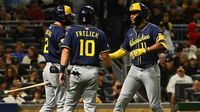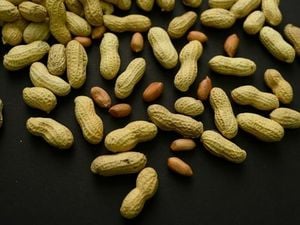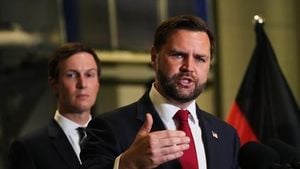As the dust settles on the Milwaukee Brewers’ 2025 season, fans and analysts alike are left with plenty to chew on. The Brewers, who stormed through the regular season with the best record in baseball, saw their World Series dreams dashed in a four-game sweep by the Los Angeles Dodgers in the National League Championship Series. Only four runs crossed the plate for Milwaukee in that series—a testament to the Dodgers’ dominant pitching and a bitter pill for a club that had defied expectations all year long.
But as Halloween approaches, the real scares for the Brewers are coming off the field, in the form of tough financial decisions and swirling trade rumors. At the center of it all stands Freddy Peralta, the 29-year-old ace who anchored Milwaukee’s rotation with a brilliant 2025 campaign. Peralta finished the season with a 17-6 record, a sparkling 2.70 ERA, 204 strikeouts across 176 2/3 innings, and a 5.5 WAR—numbers that place him among the National League’s elite. With a club option for 2026 at $8 million, Peralta’s future in Milwaukee is the subject of intense debate.
For a small-market team like the Brewers, the financial realities are always lurking in the background. Milwaukee had been enjoying the value of a five-year, $15.5 million contract signed with Peralta in 2020, but with the option years now at $8.1 million (2025) and $8 million (2026), and with the specter of a $25-30 million annual salary looming from 2027 onward, the club is reportedly listening to trade offers for their ace. As one recent report put it, "The Wisconsin outfit could undeniably afford to exercise its option and pay the gunner his $8 million. The problem is that, from 2027 onwards, the club will probably no longer be able to afford to offer him a contract worth $25-30 million per season over several years."
That’s the conundrum for general manager Matt Arnold and his staff. Do they keep Peralta for one more run in 2026, risking losing him for nothing in free agency, or do they trade him now for a haul that could keep the franchise competitive for years to come? The Brewers’ internal payroll constraints are well known—there’s no MLB salary cap or floor, but Milwaukee simply can’t compete with the deep pockets of teams like the Dodgers. As Dodgers manager Dave Roberts cheekily remarked after the NLCS sweep, his club will "continue to ruin baseball." Ouch.
Yet, the Brewers’ situation isn’t all doom and gloom. If Peralta is dealt, Milwaukee boasts one of the deepest collections of young, controllable arms in the majors. Jacob Misiorowski, who reflected recently on his "insane ascension from rookie to MLB All-Star" during the 2025 season, headlines a group that includes Quinn Priester, Chad Patrick, Tobias Myers, Robert Gasser, and Logan Henderson—all under team control through at least 2030. Myers, at 27, is the elder statesman of the bunch. Lefties Aaron Ashby and DL Hall are locked in through 2029, giving Milwaukee a formidable foundation for their rotation moving forward.
It’s not just the pitching that gives the Brewers hope. Their position player core is young, talented, and under team control for years to come. Sal Frelick, Brice Turang, and Caleb Durbin will all be just 26 in 2026, while Jackson Chourio, who turns 22 in March, is widely regarded as one of the sport’s most electric young talents. Frelick is under control through 2029, Durbin through 2031, and Chourio could remain a Brewer through 2033. Add in a pipeline of prospects like Jesús Made, Cooper Pratt, Luis Peña, Blake Burke, Brock Wilken, and 2025 first-rounder Andrew Fischer, and the future looks bright—even if the present is full of tough choices.
Still, the questions won’t wait. With starters Brandon Woodruff and Jose Quintana expected to depart via free agency, Milwaukee’s rotation could look very different in 2026. The Brewers’ reluctance to spend big in free agency is well documented, making the decision on Peralta all the more critical. As one columnist argued, "The Brewers don't typically spend big in free agency, so instead of trading Peralta and going out and signing other pitchers, they would be much wiser to keep him around. Without an anchor in the rotation, the Brewers could slip in the standings, especially with the Chicago Cubs and Cincinnati Reds having both made the playoffs in 2025."
Peralta himself has expressed a desire to stay in Milwaukee and would likely be open to extension talks. But with arbitration looming and the price tag set to skyrocket in 2027, the Brewers must weigh the risks and rewards. Trading Peralta could net a significant return, but as one observer pointed out, "What they get for Peralta won't have an immediate positive effect on the team. It will be hard to develop another pitcher of his caliber. While Jacob Misiorowski is still present, he is still partially unproven."
Meanwhile, the trade market is heating up across the league. The Boston Red Sox, long linked to Minnesota Twins starter Joe Ryan, may face competition from the Brewers themselves. Ryan, who went 13-10 with a 3.42 ERA and 194 strikeouts in 31 starts this year and made his first All-Star team, is arbitration eligible through 2027 and could be a perfect fit for a Milwaukee club seeking an established ace. According to Bleacher Report’s Kerry Miller, "Getting at least two years of an established ace-caliber pitcher would be huge in Milwaukee’s quest to keep on winning the NL Central."
Of course, adding a pitcher like Ryan would likely require giving up some of that young, controllable talent the Brewers have worked so hard to accumulate. It’s a delicate balance—one that will test the mettle of the front office as they navigate an offseason full of possibilities and pitfalls.
The Brewers’ remarkable 2025 campaign—achieved in the face of low expectations after losing Willy Adames to San Francisco and trading Devin Williams to the Yankees—has fans dreaming of sustained success. Every player from the NLCS roster could, in theory, return for 2026, though mutual options and looming free agency may change the calculus. The club’s "Golden Age" of baseball, as some have dubbed it, shows no sign of ending soon. But the next steps taken by management will determine whether Milwaukee can stay atop the National League or if they’ll be forced to reload yet again.
For now, the action has shifted from the field to the front office. Brewers fans, no strangers to heartbreak or hope, wait with bated breath to see whether Freddy Peralta will remain the face of the rotation, or if a new era—led by the likes of Misiorowski and possibly Joe Ryan—is about to begin. One thing’s for certain: in Milwaukee, the stakes have rarely been higher, and the baseball world will be watching every move.





